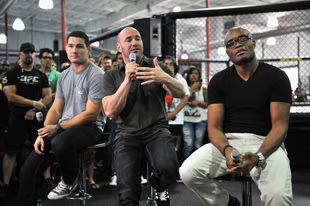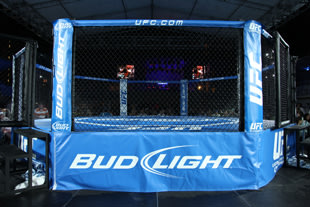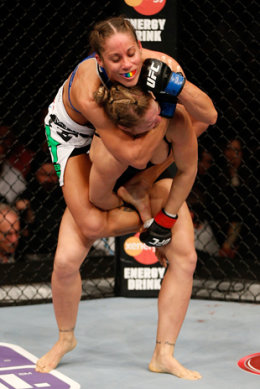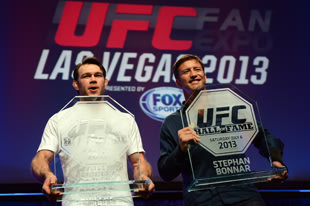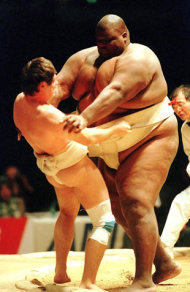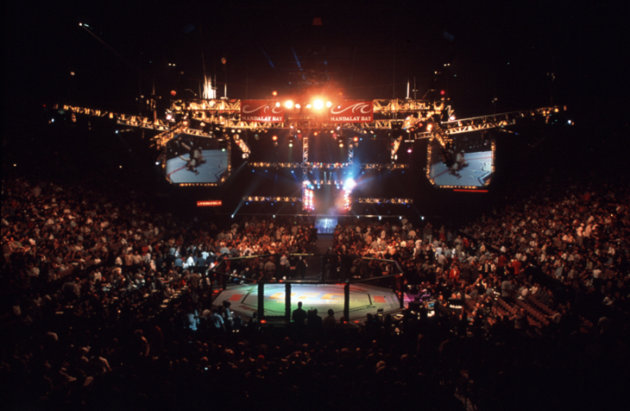
The crowd settles in to watch UFC 33, the first show in Las Vegas, one of the UFC's top moments (Getty Images)
But there were a lot of memorable moments, both positive and negative, in reaching this point. Here is one journalist's opinion of what the Top 20 are:
20. UFC makes its Las Vegas debut
As fight cards go, UFC 33 on Sept. 28, 2001, was pretty forgettable. Virtually every fight on the card at the Mandalay Bay Events Center was bad, or worse. It wasn't the kind of debut the new UFC owners wanted to make.
But the Las Vegas show was a seminal moment. It was the fourth fight under the new ownership, but this marked its debut in the Fight Capital of the World. All of the new owners lived in Vegas, and it would have been embarrassing for them to travel the world putting on shows and not do so in the leading fight market in the world.
19. UFC 37.5 is broadcast on 'The Best Damn Sports Show Period"
It was only a six-fight card, topped by a No. 1 contender's match for the light heavyweight title between Vitor Belfort and Chuck Liddell. But the shtick with this card was that the best fight on the card would then be broadcast on Fox Sports Net's "Best Damn Sports Show Period."
The show picked the Robbie Lawler-Steve Berger match, which became the first MMA bout in the U.S. broadcast on cable TV. The Best Damn Sports Show did not do anything again with the UFC, but that show was the UFC's entree into Fox. It would pay big dividends down the road.
18. Rematch between Chris Weidman and Anderson Silva announced live on ESPN's SportsCenterChris Weidman scored a stunning knockout of long-time middleweight champion Anderson Silva on July 6, 2013, in Las Vegas. A week later, UFC president Dana White appeared live on SportsCenter to announce that he'd finalized talks for a rematch, and that they would fight again in the main event of UFC 168 in December.
It was significant because rare is the time that SportsCenter devotes air time to sports it does not broadcast. It was a sign that the UFC is more and more being regarded seriously by the mainstream media, a battle promoters have been fighting for 20 years.
17. Zuffa purchases Strikeforce on March 12, 2011
By this point, it was obvious that the UFC had won the fight and was going to be MMA's dominant promotion going forward. But Strikeforce was a plucky competitor and was having much success as the No. 2 promotion.
It had fight cards on both CBS and Showtime and it was regularly putting on top-notch fight cards.
When Zuffa purchased it, it gave the UFC the overwhelming majority of the world's finest MMA talent. It also effectively ended the thought of any challenger to the UFC's dominance.
16. UFC lands Bud Light as a sponsor in 2008For all the success the UFC was having up to 2008, it was hurting when it came to big name sponsors. It didn't have the partnership with Fortune 100 and Fortune 500 companies that established leagues like the NFL, NBA and Major League Baseball have long enjoyed.
When White announced that the company had a sponsorship deal with Anheuser Busch, it was a big deal.
15. Chuck Liddell TKOs Tito Ortiz in rematch in first million-selling PPV
UFC 66 was the rematch between Liddell and Ortiz, the company's biggest stars. The bout was covered intensely by media and the crowd was at a fever pitch at the MGM Grand in Las Vegas when the fight began.
The big news came later, when it was revealed that the bout sold just over 1 million pay-per-view. No more was anyone looking at the UFC's success as a fluke, or a fad. Fewer than 20 boxing matches in history had sold over 1 million to that point, and the UFC's ability to do so gave it instant credibility.
14. Ortiz destroys Ken Shamrock at UFC 40
Ortiz and Shamrock very much disliked each other, and the tension was palpable whenever they were close to one another. The promotion was intense and a brawl nearly broke out at the pre-fight news conference.
That bout was the biggest in history at the time, and Shamrock's ties to the WWE brought in fans who hadn't seen mixed martial arts before. It was a big step in the UFC's development.
13. UFC adds a women's divisionWhite was long a naysayer when it came to women's fighting. But when he saw Ronda Rousey fight Miesha Tate in Strikeforce in 2012, he was a convert. That bout convinced him to bring women to the UFC.
The first fight with women on the card was at UFC 157 on Feb. 23, 2013, when Rousey met Liz Carmouche at the Honda Center in Anaheim, Calif. The bout generated enormous attention from the mainstream media. Rousey was profiled on HBO's Real Sports and got attention from outlets that usually ignored MMA.
12. Sen. John McCain refers to MMA as "human cockfighting"
A lifelong boxing fan, Sen. John McCain (R-Ariz.) was no fan of MMA. In 1996, he sent a letter to all 50 governors urging them to ban the sport. He infamously referred to it as "human cockfighting."
The next year, he appeared on a segment on "Larry King Live" on CNN, along with Marc Ratner and Shamrock. Ratner, now a UFC vice president but then the respected executive director of the Nevada Athletic Commission, sided with McCain against the UFC and MMA.
Those two words -- human cockfighting -- and the meaning were used again and again against the UFC as it was trying to build.
McCain, though, appeared in a Fox-produced documentary, "Fighting for a Generation," about the UFC's 20th anniversary, signifying that he approved of the changes the UFC had made.
11. UFC purchases the WECIn late 2006, the UFC purchased the World Extreme Cagefighting organization. After running it as an independent organization for four years, the WEC was folded into the UFC in 2011.
That gave the UFC a slew of great fighters, notable and popular fighters such as Urijah Faber, Dominick Cruz, Anthony Pettis and Benson Henderson, as well as weight classes below 155.
Adding the 135- and 145-pound weight classes to the UFC energized the promotion and brought the athleticism to the cage that made the WEC so popular.
10. UFC draws in excess of 55,000 to Toronto's Rogers Centre for UFC 129
Any event that can draw 55,000 or more fans is one that needs to be taken seriously. And the UFC's success in its international expansion, which took it around the globe, was exemplified nicely by the reaction to UFC 129.
The massive crowd came early and stayed late, and was another major step on the UFC's hard road toward mainstream acceptance.
9. The UFC gets into the reality show craze, creates 'The Ultimate Fighter'
In 2004, when the UFC was bleeding millions and the owners were considering selling the company, it created the reality series, 'The Ultimate Fighter.' They hoped it would be the Trojan horse that would get the UFC into the home.
White and the Fertittas couldn't find a network that was interested, so they funded Season 1 themselves on Spike.
It was a stroke of genius that saved the company and brought it a stream of high-end talent.
8. UFC/Spike officials renew deal, sign TV contract after tremendous TUF 1 Finale
Forrest
Griffin defeated Stephan Bonnar in the finale of Season 1 of TUF in
what is one of the great fights in UFC history. But it was also the
fight that, quite literally, saved the company.It was so good, and Spike executives were so stoked, that they walked into an alley outside the Cox Pavilion in Las Vegas, where the fight card was held, and hammered out a new deal with White and the Fertittas that not only guaranteed there would be future seasons of TUF, but which also gave the UFC a basic cable outlet to show fight cards.
7. Joe Silva was hired as UFC matchmaker
Dana White is the man most responsible for the UFC's success, but ask White who his most indispensable employee is and he'll quickly tell you Silva.
Silva was hired by Campbell McLaren, one of the UFC's first employees, not long after UFC 1. Silva had written a lengthy letter to McLaren detailing what he thought should be done to turn the spectacle that was the early UFC into a sport and, more significantly, a viable business.
The majority of Silva's points were taken, and led in large part to the UFC's success today.
No one knows more about the fights or the fighters than Silva, and without him, the UFC wouldn't be nearly the same.
6. UFC purchases PRIDEThe PRIDE Fighting Championship was the competitor to the UFC in the early days of the sport. It put on some huge shows and was enormously successful in Japan, where it developed fighters such as Fedor Emelianenko, Mirko "Cro Cop" Filipovic, Quinton "Rampage" Jackson, Mauricio "Shogun" Rua and others.
In 2007, the UFC bought PRIDE and absorbed nearly all of its fighters into the UFC, in large part fulfilling White's dream of being able to consistently match the best fighters in the world against each other.
5. New Jersey adopts the unified rules
When the New Jersey State Athletic Control Board adopted the unified rules of mixed martial arts in 2000, it signified a new era and a break from the UFC's renegade past.
There were weight classes and a long string of rules aimed at fighter safety. Those rules led to every other state but New York to regulate MMA.
Without those rules, there might not be a sport of MMA today.
4. UFC 100 is a massive draw
UFC 100 is reportedly the highest-selling PPV in company history. It was a mega-event that was almost like a celebration of mixed martial arts.
Heavyweight champion Brock Lesnar not only retained his title by pummeling rival Frank Mir, he then outraged UFC management when he said in an angry post-fight interview that he'd go out and drink Coors Light instead of UFC sponsor Bud Light.
But the large show and its resulting success pushed the UFC forward significantly.
3. Zuffa purchases the UFC from Semaphore Entertainment Group
In
January 2001, Zuffa purchased the dying UFC from Semaphore
Entertainment Group for the measly price of $2 million. There may have
been others who were willing to buy the company, but no one was beating
down the door looking to do it.Zuffa's ownership ensured the UFC would be well-capitalized and would have creative owners with a sound business plan who could make the sport to the next level.
2. The early years develop a cult following
The
sight of 170-pound Royce Gracie defeating men significantly larger than
he was inspired many future fighters to take up the sport. And who
didn't get a kick out of seeing a 618-pound sumo wrestler, Emanuel
Yarbrough, take on 190-pound kick boxer Keith Hackney?There were many crazy stories in the UFC's early days, as the sport struggled for an identity. In the early seconds of UFC 1, Gerard Gordeau kicked the teeth from the mouth of Telia Tuli. Later in that show, highly ranked boxer Art Jimmerson, with one glove and one bare hand, submitted to a Royce Gracie arm bar.
Those early years were a circus in many ways, but they also helped forget what the UFC would become.
1. UFC announces a television deal with Fox
In 2004, as he was looking for a way to dig out from under more than $40 million in debt, White could not have ever imagined he'd sign a seven-year deal with Fox. But in 2011, that's just what happened.
Fox put the UFC on network TV for the first time, gave it exposure all over cable and treated MMA like a major sport on par with any of the others it regularly carries.
It's the deal that is leading the UFC into the future and will shape it for the next generation

